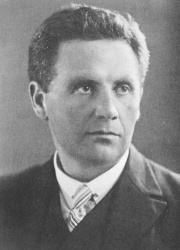Related Research Articles
The year 1867 in science and technology involved many significant events, listed below.
The year 1934 in science and technology involved some significant events, listed below.
The year 1912 in science and technology involved some significant events, listed below.
The year 1916 involved a number of significant events in science and technology, some of which are listed below.
The year 1917 in science and technology involved some significant events, listed below.
The following events in science and technology occurred in the year 1918.
The year 1920 in science and technology involved some significant events, listed below.
The year 1922 in science and technology involved some significant events, listed below.

George Charles de Hevesy was a Hungarian radiochemist and Nobel Prize in Chemistry laureate, recognized in 1943 for his key role in the development of radioactive tracers to study chemical processes such as in the metabolism of animals. He also co-discovered the element hafnium.
The year 1942 in science and technology involved some significant events, listed below.

The Weizmann Institute of Science is a public research university in Rehovot, Israel, established in 1934, fourteen years before the State of Israel was founded. Unlike other Israeli universities it exclusively offers postgraduate-only degrees in the natural and exact sciences.
The year 1891 in science and technology involved some significant events, listed below.
The year 1882 in science and technology involved some significant events, listed below.
The year 1924 in science and technology involved some significant events, listed below.
The year 1939 in science and technology involved some significant events, listed below.

Dirk Coster was a Dutch physicist. He was a professor of Physics and Meteorology at the University of Groningen.
The Asahi Prize, established in 1929, is an award presented by the Japanese newspaper Asahi Shimbun and Asahi Shimbun Foundation to honor individuals and groups that have made outstanding accomplishments in the fields of arts and academics and have greatly contributed to the development and progress of Japanese culture and society at large.
References
- ↑ Chartrand, Mark (September 1973). "A Fifty Year Anniversary of a Two Thousand Year Dream (The History of the Planetarium)". The Planetarian. 2 (3). International Planetarium Society. ISSN 0090-3213. Archived from the original on 2009-04-20. Retrieved 2009-02-26.
- ↑ O'Dell, Larry. "Anti-Evolution Movement". Encyclopedia of Oklahoma History & Culture. Oklahoma Historical Society. Archived from the original on 2010-10-18. Retrieved 2010-09-13.
- ↑ Zoologische Jahrbücher (Physiologie)40: pp. 1–186.
- ↑ Coster, D.; Hevesy, G. (20 January 1923). "On the Missing Element of Atomic Number 72". Nature . 111 (2777): 79. Bibcode:1923Natur.111...79C. doi: 10.1038/111079a0 .
- ↑ Hevesy, G. (1925). "The Discovery and Properties of Hafnium". Chemical Reviews . 2: 1. doi:10.1021/cr60005a001.
- ↑ Bohr, N.; Coster, D. (December 1923). "Röntgenspektren und periodisches System der Elemente". Zeitschrift für Physik A . 12 (1): 342–374. Bibcode:1923ZPhy...12..342B. doi:10.1007/BF01328104. S2CID 120877752.
- ↑ According to chemistry historian Henry M. Leicester.
- ↑ Singh, Simon (1999). The Code Book: the Science of Secrecy from Ancient Egypt to Quantum Cryptography . London: Fourth Estate. ISBN 1-85702-879-1.
- ↑ Zobel, O. J. (1923). "Theory and Design of Uniform and Composite Electric Wave Filters". Bell System Technical Journal. 2: 1–46. doi:10.1002/j.1538-7305.1923.tb00001.x.
- ↑ Capgras, Joseph; Reboul-Lachaux, Jean (1923). "Illusion des "sosies" dans un délire systématisé chronique" [Illusion of "doubles"]. Bulletin de la Société Clinique de Médicine Mentale. 2: 6–16.
- ↑ Fastovsky, David. "Life and Death in a 70 Million-Year-Old Sand Sea" . Retrieved 2011-02-14.
- ↑ AMNH 6515. Osborn, Henry F. (1924). "Three new Theropoda, Protoceratops zone, central Mongolia". American Museum Novitates (144): 1–12. hdl:2246/3223.
- ↑ Haines, Catharine M. C. (2001). International Women in Science: A Biographical Dictionary to 1950. Santa Barbara: ABC-CLIO. p. 12. ISBN 978-1-57607-090-1.